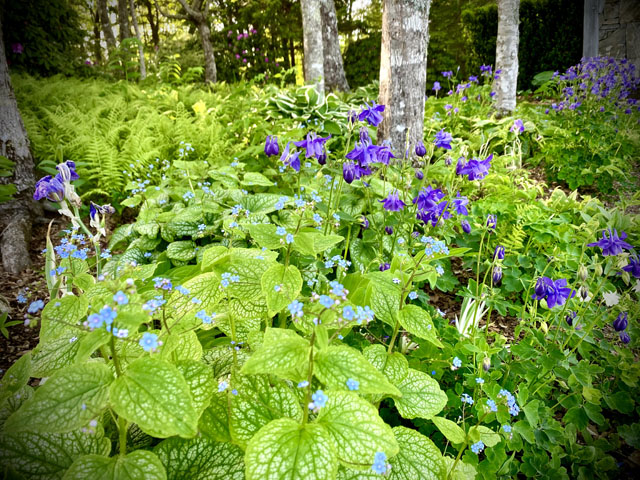Perennial Renewal
03 Apr 2025
Spring cleaning in the garden
April-May 2025
Written By: KRISTIN LANDFIELD | Images: KRISTIN LANDFIELD

This was a cold winter — one of the coldest I remember, which made spring’s seemingly slow arrival all the sweeter for our privation. Eventually, longer days crept their way past frigid evenings, sneaking with them precious green shoots on willows and the sunny insouciance of daffodils that flourish even under a late dusting of snow.
Now, spring’s presence is irrefutable: insistent, resounding. If we were not so desperate for her company, spring might even seem gaudy. Instead, we delight in her raucous presence. In April’s easy warmth, we humans discard our heavy jackets, sensing a friendly breeze from the south. While we shed our contrived layers, the naked landscape of winter has been suiting up. Ebullient birdsong rings out from newly clothed trees that stand proud in their fresh green wardrobe. Each diurnal arc further adorns the scene: Bright green growth bounces on heavy boughs of hemlock trees, fiddlehead ferns unfurl like quiet ballerinas on a time-lapse camera and the pink tips of serviceberry buds open to fine white blooms that gently adorn the native woods.
In the Appalachian Mountains, the flowers of these understory trees once served as temporal markers. Spring was here, so itinerant preachers could once again travel for “sarvices,” allowing people to baptize, to wed and to bury their dead. The humble flowers bore testament to spring’s vernal order: one of assured renewal. Meanwhile, purple bird-foot violets spill from rocky cracks, and trout lilies emerge bright amidst last fall’s leaf litter as though amused by the sunlight that warms their swept-back yellow faces. Woodland phlox roll boldly in a blush carpet across a mossy floor; pretty little moths flutter around wet rocks that glisten with the drip of spring. In the ever-tardier evenings, dueling bullfrogs create a magical racket. April is a showoff.
In spring’s symphonic pageantry, instinct is the conductor. Although instinct always acts as nature’s driver, spring heightens its compulsion for action, much like seasonal osmotic pressure forces sap to rise in the xylem of woody plants. Spring appears and the whole hemisphere responds, driven more by urge and impulse than by any proximate cause. Cosmology acts on biology, yielding animal instinct and vegetative patterns. We, too, are enlivened by the lengthening of days, the friendlier temperatures and the predilections of our ancestors, who moved beyond the equinox seeking the promise of a nourishing season ahead.
For me, gardening in spring is as much about instinct as it is about horticultural rules and manuals. I am itching to peel back the crinkly layers of winter and shed last year’s lifeless cells, allowing May’s bright skies to coax open a kalmia’s burgeoning buds. Much like the sudden urge to clean our indoor abodes, the drive to tidy a spring garden can arrive as an assault. One day, the garden is still resting; the next day, it surges, and I feel the urge to whip it into shape. Some of this urge is simply pragmatics. It is finally warm enough to fling open the windows, shake out the rugs and empty the ashes from the hearth. It is likewise warm enough to work the soil and prepare for the coming season of growth.
These practices somehow feel more primeval than rational, perhaps reflecting our innate tendencies toward preparation and care. Humans have practiced spring cleaning for thousands of years, commonly aligning these rituals with spiritual traditions. As an act of devotion, spring cleaning is in accord with motifs of renewal: One clears the cobwebs of the heart to prepare for the promise of regeneration. Such customs corroborate universal themes of rebirth and validate our place in the perennial cycles of nature.
Ironically, spring cleaning in the garden is ultimately about dirt. We, as gardeners, mingle with the regenerative nature of the soil that feeds us. Indeed, a day spent tidying a garden is a squeegee for the spirit. Research demonstrates that physical contact with rich soil yields positive effects on mental and physical health. Anyone who has felt the clean goodness of fertile soil intuits this to be true, even without the research to validate the intuition. Live soil is a universe unto itself, a vibrant reservoir for microorganisms, and one through which we should tread lightly — literally.
When beds are mucky and saturated with spring rains, it is best to avoid heavy activity, but compaction is worse than inaction. Also, aggressively tackling a spring garden cleanup can be appealing, but paradoxically, stripping all the debris and old mulch works against regenerative efforts. In limited cases, comprehensive removal may make sense, as with certain plants that are susceptible to pathogens harbored in debris or when excess organic matter is smothering the crowns of plants. For the most part, however, we tend to strip beds too scrupulously, then pile too-thick engineered mulch back into beds in an absurdist’s folly.
Instead, plants themselves provide the most essential components for bed prep. There is no better mulch than native leaf litter, especially from the respective plants’ own senesced foliage. When listening to bullfrogs bellow, it is obvious that these creatures operate by instinct, an instinct that emerges in accord with their evolutionary lineage. Plants’ lifecycles also obey natural rhythms. The previous year’s dying vegetation feeds the coming year’s growth and health. In a beneficial system, the plant itself endows the surrounding soil with the very nutrients that will perfect its resources over time. Aggressive removal interrupts this process, preventing time and matter from working their alchemy in the landscape.
Still, we are human, and organization appeals to us. A cultivated garden communicates well-being. I prioritize more fastidious clean up around the edges of beds, near walkways, along a main sightline, etc., so the space conveys order and care. In areas further from walkways and buildings (i.e., deeper into beds, under most trees and shrubs), I allow more leaf litter. Ideally, I remove just enough to promote good air circulation and avoid smothering the crowns of plants. This can likewise confer casual appeal to a garden. Metaphorically, I want to clean the tiles without destroying the grout. This year, as the sap rises and instinct drives me to garden, I will internalize the words of Longfellow, who wrote of spring: “ ... Let us, then, be up and doing, / With a heart for any fate; / Still achieving, still pursuing, / Learn to labor and to wait.”













